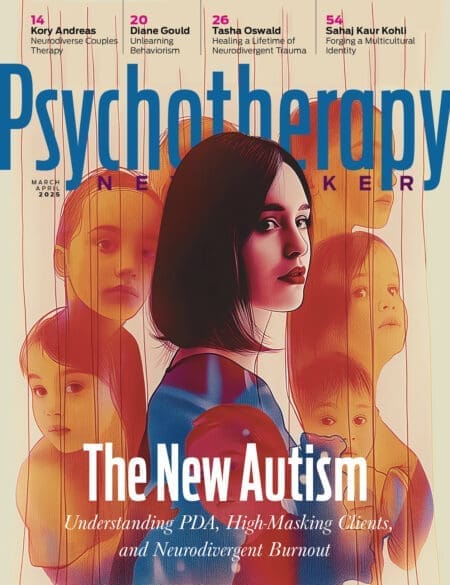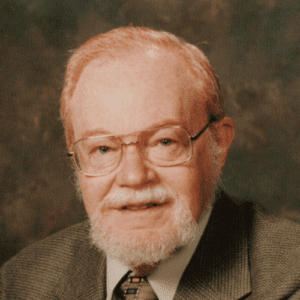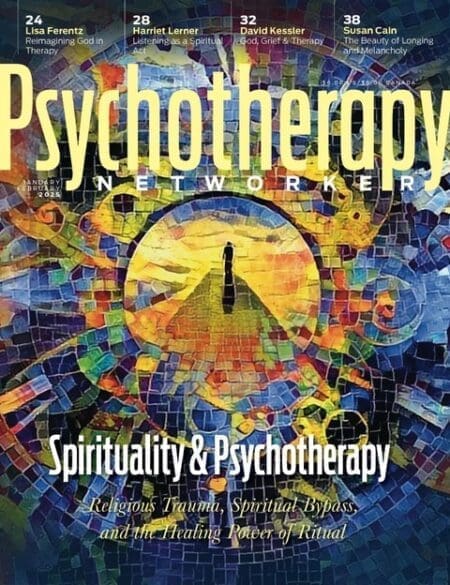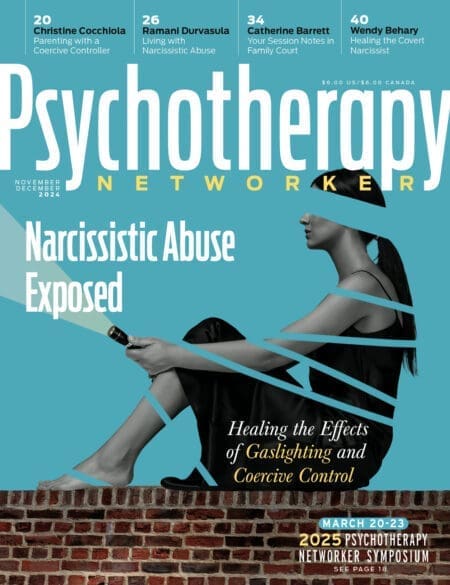During my third meeting with Aaron, a painfully shy college student, I proposed trying an odd therapy experiment: he’d send himself on an imaginary two-week vacation. While he was away, a character named Carl (Aaron’s middle name) would take his place, going to his classes, and playing cello in the orchestra. To avoid confusion, Aaron would continue to answer to his first name, but internally, he’d think of himself as Carl.
Before we began the experiment, Aaron and I went over Carl’s attributes in detail, making sure that he considered Carl the kind of person he might like to meet and get to know. I wanted Carl to be different from Aaron, but not so different that he’d find the character mystifying or impossible to embody. In my conception, Carl was an introvert, like Aaron. But whereas Aaron considered himself timid and fearful, Carl simply thought of himself as more of a friendly observer than a talker. He enjoyed hearing what others had to say and was a good listener. He sat closer to the front of the classrooms than Aaron tended to, and while he didn’t actively raise his hand to answer questions, he didn’t avoid them either. Because Carl’s focus wasn’t on himself, he didn’t worry much about whether or not he was making a good impression.
I explained that after the two weeks were up, Aaron would be free to make use of any insights he’d gained while experiencing the world through Carl’s eyes. The intention was not for him to become Carl permanently, nor were we saying that Carl was a superior person. The goal was simply to give Aaron a chance to view aspects of life from a different perspective.
Aaron agreed to try the experiment. During it, he and I met a few times to assess how it was going and troubleshoot any situations in which Aaron was confused about how Carl might behave. During one of those sessions, I suggested that Aaron notice how many other students in his classes actually raised their hands to ask questions versus how many tended to stay silent like him, or in the student union, to see how many individuals actually dominated conversations versus how many tended to listen like him. My sense was that he’d come to see how overfocusing on his own shyness had led him to overestimate the extraversion of others.
This kind of therapy experiment, in which a person pretends to be someone else, was invented by personality theorist George Kelly, who dubbed it fixed-role therapy. A former high-school drama coach, he had noticed that student actors were often deeply affected by the roles they played. He realized that something that begins as mere pretense can become an enduring facet of one’s personality. When he became a therapist years later, he made use of that insight, searching for ways to help clients explore “some novel hypotheses about other ways of living.” Fixed-role therapy, buried within his mammoth body of work, isn’t especially well-known, but the method is nonetheless quite useful and easily adaptable, regardless of your clinical specialty. Simple versions of the method are well within reach of ordinary practitioners.
As you might expect, the key ingredient in fixed-role therapy is make-believe. Clients are invited to temporarily act like someone they are not. The method, Kelly wrote, is a creative process between the therapist and client. “Any attempt to make it a repair process rather than a creative process,” he noted, “seems to result in some measure of failure.” Clients of all sorts can be asked to try on characters. A habitually tardy client might see what it’s like to be the first to arrive at an event. A pessimistic client might try on a sunny disposition. A penny-pinching client might experiment with being more charitable toward others. A self-conscious client, like Aaron, might pay more attention to what others are doing rather than constantly worrying about what they think of him.
Obviously, the theater isn’t the only place where character transformations occur. Years ago, one of my young clients attended a Halloween party wearing a mummy costume. He later told me how he’d marched around the room in stiff-legged mummy fashion, comically bumping into other costumed partygoers. It was something this reserved young man wouldn’t have dared to do as himself. The role of the mummy had given him permission to take more risks and participate more actively in this and subsequent social settings.
Kelly recommended that therapists introduce the fixed-role experiment toward the start of treatment, before therapist and client have spent much time focusing on symptoms, complaints, and fixes. Together, they agree on the duration of the experiment, although between two weeks and a month is usually an adequate amount of time to see results. They also settle on a name for the alternative persona. As in Aaron’s case, Kelly often used the client’s middle name. Finally, before the experiment begins, the therapist conducts an “acceptance check” to verify that the client understands the role and is willing to give it a try.
The context can be narrowed, too, focusing on, say, interactions at the client’s workplace, or in small, nonwork settings, such as a local bar or coffee shop. It can be employed at singular events like birthdays, weddings, family reunions, or shopping trips. And rather than being framed as some kind of grand project, it can simply consist of a casual suggestion that the client try on a different perspective for a few hours or a few days. In other words, flexibility and creativity is the name of the game.
Try It on For Yourself
Fixed-role therapy isn’t just for clients looking to make changes. Kelly suggested that even people who are relatively content with their lives might consider reinventing themselves from time to time. “A good deal is said these days about being oneself,” he wrote. “This strikes me as a very dull way of living. I would be inclined to argue that all of us would be better off if we set out to be something other than what we are…Perhaps it would be more accurate to say life would be a lot more interesting.”
Legend has it that Kelly practiced what he preached. When he became director of the clinical psychology program at The Ohio State University, he was given the unpopular task of downsizing the program. In the first days of his administration, he surprised everyone by coming to work in overalls, as if he was still on his family’s Kansas farm. Dressed in this unusual attire, he met individually with each student and ruthlessly persuaded many of them to switch to other fields, such as developmental or social psychology. When he’d whittled the class down to a workable size, he abandoned the overalls and showed up to work the next morning in more traditional academic garb—a jacket and tie. At the same time, his personality was said to have transformed overnight, from ruthless to friendly. If this tale is true, Kelly purposefully modified his personality to fit the task at hand. He was harsh when harshness was required, and nurturing when nurturance was more appropriate. His change of clothing marked the transition, perhaps for Kelly himself, as well as for those around him. It’s a story of transformation that’s fascinated generations of graduate students, myself included.
Personally, I’ve learned and grown from the fixed-role model, too. A few years ago, before attending a faculty party, I engineered a fixed-role experiment of my own. My plan was to see what happened if I broke the norm for such events and socialized as little as possible. For most of the evening, I sat quietly on a couch nursing a drink. To my surprise, nobody seemed to notice or care that I wasn’t actively engaged in meeting people or making conversation. This one-night experiment confirmed what I’d suspected: that the rules of social engagement are much less rigid and demanding than most people imagine. This observation has served me well, both in my own life and when discussing social anxiety with clients like Aaron.
Small Adventures
The fixed-role paradigm has inspired me to invent some more modest exercises that encourage clients to step outside of themselves and their comfort zones. I’ve found that even tiny shifts in a client’s routine can generate meaningful therapeutic change. For example, I suggested to one client that she sit on a particular park bench, at a particular time of day, for a specified time (excluding days with poor weather). During this time, I told her, she was not to read, listen to music, or check her phone. I had no idea what, if anything, this assignment would produce, but at the next session, she reported that sitting quietly on the park bench had given her the space to think clearly about her life goals and to formulate a concrete plan for switching jobs.
I told two other clients to read a particular suspense novel. After this assignment, one of them—a businessman who’d complained of having few interests—made reading mysteries his new hobby. The other client, after reading the same book, had a totally different reaction. “I know why you wanted me to read that book,” he said. “The main character is selfish and self-centered, and I can sometimes be selfish, too. Maybe I need to work on that.” Of course, I’d made no such connection. I’d simply chosen the book because it was a great read!
In another case, I asked a client who used public transportation to get off at a different stop on his way home and, if feasible, to walk the rest of the way. I proposed that he explore whatever neighborhood he found himself in as if he was a tourist visiting a foreign city. Again, the result was unexpectedly profound. He’d been working frantically to meet a work deadline, but when he began strolling through a new neighborhood and noticed residents simply going about their business at a leisurely pace, he began to wonder how he’d allowed an ultimately trivial work assignment to dominate his day and mood.
Not only did these tiny disruptions in my clients’ lives produce some surprisingly robust results, but each client managed to find some deeper wisdom I never could’ve anticipated in these seemingly innocuous tasks.
As for Aaron, his two weeks as Carl were quite productive. In his words, the experience jump-started a side of him that participated more in life. Although he said sitting at the front of the class had felt scary at times, it also allowed him to live more courageously. When the teacher called on him and he answered, he realized the sky wouldn’t fall if his response wasn’t perfect. On a few occasions, his teachers even praised him for his keen insight. Aaron realized how much he’d been missing by hiding in the back of the room. “Being shy was easier,” he said, “but it’s much less fulfilling.”
Aaron also told me about an afternoon when, as Carl, he agreed to give a fellow orchestra member he didn’t know particularly well a ride home. He admitted it was something Aaron never would’ve done. “But instead of dwelling on whether or not he’d like me or what we’d talk about, I just did it,” Aaron recalled. “We wound up getting along really well, and he actually invited me to his Christmas party!”
A year after his fixed-role adventure, Aaron, normally averse to change, took the plunge and transferred to a college with a better music department. “I’m still not quite as outgoing as I’d like to be,” he emailed me a few weeks after transferring, “but I’m getting there.”
Salvador Minuchin, toward the end of his long career as a family therapist, noted that his therapy had always been about informing people, in one way or another, that life offered more possibilities than they had envisioned. It’s the same message contained in George Kelly’s dictum that “whatever exists can be reconstrued.” Fixed-role therapy, in its original form and in its less formal variations, gives clients the opportunity to see the world differently, to step outside of themselves and their routines long enough to take a peek at something brand-new.
ILLUSTRATION © ADOBESTOCK/MICHAEL
Jay Efran
Jay Efran, PhD, professor emeritus of psychology at Temple University. He received the Pennsylvania Psychological Association’s 2009 award for Distinguished Contributions to the Science and Profession of Psychology and is co-author of Language, Structure and Change and The Tao of Sobriety.












